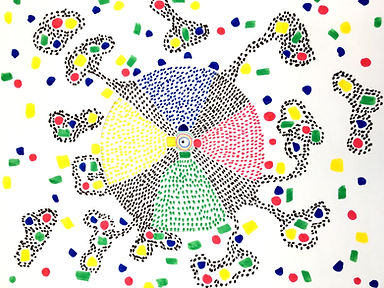CCT Specialization Course
Contemplative Circle Method (CCM):
On Mandala and Healing Circles
Across cultures and centuries, people have gathered in circles to heal, share stories, and reconnect with one another and with the sacred. Whether in Indigenous healing circles, Tibetan sand mandalas, Christian rose windows, or Jungian mandala drawings, the circle has symbolized wholeness, balance, and interconnectedness. Mandala and healing circle traditions remind us that individual well-being is inseparable from the health of community, culture, and environment.
In contemplative traditions, mandalas serve not only as sacred art but also as a mirror of the mind, mapping inner landscapes of thought, emotion, and awareness. Similarly, healing circles provide a dynamic structure that enables participants to witness and support one another, fostering resilience, compassion, and transformation. Both practices embody the principle that healing is not a linear process but a cyclical one, unfolding through presence, relationship, and symbolic expression.
In modern therapeutic and educational settings, integrating mandala and healing circles offers powerful resources for trauma recovery, emotional regulation, and meaning-making. By blending symbolic art, contemplative practice, and collective dialogue, practitioners can create safe and generative spaces for clients and communities.
At The Lojong Center, these cross-cultural and interdisciplinary insights have been developed into the Contemplative Circle Method (CCM), a framework that combines contemplative presence, creative exploration, and clinical application. The method provides clinicians and facilitators with a way to integrate the timeless wisdom of mandalas and sacred circles with evidence-informed therapeutic approaches, thereby cultivating both personal insight and collective healing.



Course 1 - Overview:
A 4-module online course that explores the origins and contemporary applications of mandala and healing circles as pathways to integration, resilience, and collective healing. Drawing from cross-cultural traditions and contemplative psychology, it examines how sacred forms and communal practices can be adapted for therapeutic and educational contexts. The course culminates in the introduction of the Contemplative Circle Method (CCM), developed at The Lojong Center, which brings together contemplative presence, creative expression, and clinical practice.
Purpose of the Course
This course introduces the origins and evolution of mandala and healing circles across cultures and traditions, examining their role in spiritual, artistic, and therapeutic contexts. Participants will explore how these forms of collective and contemplative practice support healing, meaning-making, and integration. At The Lojong Center, these insights converge into the Contemplative Circle Method (CCM), a contemporary framework for clinical and community settings.
Participants will gain insight into:
-
The symbolic, spiritual, and cultural significance of sacred circles and mandalas.
-
How contemplative circle-based methods foster safety, belonging, and transformation.
-
Practical approaches for integrating mandala and circle work into clinical and community practice.
-
The foundations of the Contemplative Circle Method (CCM).
Key Themes:
-
Mandala and sacred circle traditions as universal symbols of wholeness and healing
-
Cross-cultural roots of healing circles and their shared principles
-
Yantra and mandala as contemplative art and psychological map
-
Collective presence, safety, and transformation in circle practices
-
The Contemplative Circle Method (CCM): integrating contemplative, creative, and clinical approaches
Designed for:
This online course is designed for psychotherapists, art therapists, mindfulness facilitators, educators, and other mental health professionals who wish to integrate a Contemplative Creative specialization into their clinical or teaching practice. It also resonates with contemplative practitioners who seek to bridge personal insight with professional application, bringing contemplative depth to their work with individuals and groups.
For this online course, prior experience with meditation or completion of the foundational training in Contemplative Creative Therapy (CCT) is recommended, as the material builds on core contemplative and creative principles.
